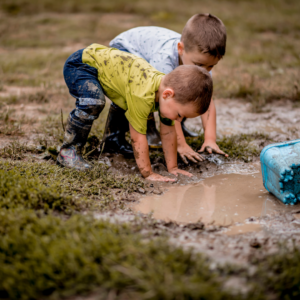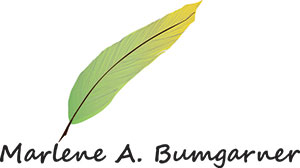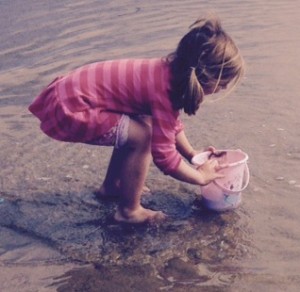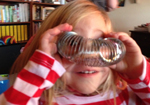 When I was about eight, my parents spent a weekend helping some friends prepare their family farm for an estate sale. While the adults sorted, stacked, and scoured, the children were left to roam free. I remember climbing into a hay loft that first day, eating my fill of tart red currants directly off the bush, and rocking an old buckboard back and forth on its springs, pretending I was driving a stage coach in the Wild West.
When I was about eight, my parents spent a weekend helping some friends prepare their family farm for an estate sale. While the adults sorted, stacked, and scoured, the children were left to roam free. I remember climbing into a hay loft that first day, eating my fill of tart red currants directly off the bush, and rocking an old buckboard back and forth on its springs, pretending I was driving a stage coach in the Wild West.
But mostly I remember the mud.
One of the children suggested we catch some tadpoles at the creek that ran below the barn. An accommodating woman working in the farm kitchen gave us each an empty jar, and we waded into the shallow water to try and persuade them to swim into our vessels. We gave up after several frustrating tries, but soon became intrigued by the sucking, squishy nature of the muddy clay at the bottom of the creek. As we walked, our feet sunk into the mud, making a squeaky sucking noise as we pulled them out for each step. Squelch, squelch, squelch. As I remember it, we hauled handfuls of the mud up onto the creek bank, then after squeezing out the excess water we began throwing mud balls at the trees and one another. That was fun for a while, but eventually the texture of the mud consumed us and we began handling it, building hills and walls and rivers like we were at the beach. Some of us, having studied the California Indians in school, were soon making villages and bowls and sculptures out of the soggy clay. More children joined in, and we became so engrossed in what we were doing that the time just slipped away.
Sometime around dusk our parents retrieved us from the creek (probably directed there by the kitchen helper). Before I could wonder if we were in trouble, my mother took off her shoes and waded into the water with me, washing off most of the mud before wrapping me in a blanket and packing me back into the car we’d come in. No scolding, no punishment. Only — “I wish you’d thought to take off your dress before you got so mucky.” The second day we were back at it again, this time dressed in more accommodating clothing, and with tools that we had collected from our various homes. At the end of the day I managed to talk my parents into letting me take home a mud sculpture of a woman’s head that I had worked on for hours, and it sat on a windowsill for months, gradually drying out and crumbling until someone threw it away. But the creating of that head had been an absolutely wonderful experience. I can still remember how slippery and gooshy the mud felt in my hands as I pushed in the eye sockets, fashioned eyebrows and hair with a stick, and smoothed the mouth into a smile.
No Scolding
What amazes me now is that no one scolded us for playing in the creek, for taking glass jars into the water, or for getting ourselves totally covered in muck. The only embarrassing outcome of our escapade was that as we walked up the hill the second day, dripping wet and filthy, to where our parents had gathered after their labors, we were greeted by a rousing chorus of grinning grownups singing “Mud, Mud, Glorious Mud!” Parents in those days expected their children to play freely, and they expected them to get dirty.
Mud is great stuff. Poet e. e. cummings described an early spring day as “mud-luscious and puddle-wonderful.”
Can’t you just feel the slimy mud as you read those words?
A Confession
When my dear Bean recently discovered a medium-sized puddle in a park, she and her five year old companion decided to “paint” their scooters with the brown glop. On the way, they covered their shoes, their pants, their hands, and somehow managed to get it in their hair as well. I was chatting with her companion’s mother, and when we saw what they were doing, we walked over to . . . I don’t know, stop them? To our credit, we managed not to scold, well aware that in drought-ridden California mud puddles are miraculous rarities. And we weren’t really angry. How could we be? The girls were grinning with pleasure at what they had done. Still, we somehow felt it necessary to get the mud off the scooters and try to save the shoes. Biting back smiles as we did so, we made them both stop playing and escorted them to the park restrooms where we cleaned off the mud as well as we could with water and paper towels. Chagrined now, the girls lost their pride and exuberance as they obediently helped us remove the mud from their belongings. We were definitely the bad guys who brought down their mood. And for what?
I’ve thought about that day many times since and I have written several new endings to the story in my head, all of which have me and my friend simply going along with the flow, recognizing the glory of the mud, and letting the girls play it out. Outdoor play, without oppressive adult supervision, can offer children a sense of freedom and creativity unlike any indoor play I have ever seen. Sticks, stones, mud, gravel . . . don’t you remember? Lots has been written about this. I teach about the benefits of mud play in my child development classes. But actually letting it happen? For this grandmother, that turns out to be a little more difficult.
Magic Mud
We hadn’t been to the beach lately, and recently, Bean had taken to adding sand from the sandbox into her water table which stands nearby, stirring it, filling containers with it and pouring it out, setting plastic bugs into the silty bottom of her girl-made seascape. At first I cleaned out the water table each day after she left. Then I began to sit nearby and watch her, marveling at the science that she is learning, listening to the running commentary she was keeping up for the benefit of her several stuffed animal “buddies” sitting in a nearby wagon, and imagining how nice it must feel to have her hands up to her elbows in the cold water, running the sand between her fingers. It was during one of those occasions when I remembered playing in the mud during that enchanting weekend so long ago.
Bean is afraid of the waves when we go to the beach, so mostly she plays in the dry sand. But last time we went we found a small lagoon that had been created from the tide, which was out at the time. In an earlier post I described her filling an afternoon with moving wet sand from one place to another. As my own memories came back I began to understand why she found that such a satisfying experience.
A Commitment
The next time mud shows up in our lives, or when I feel we can spare enough precious water to pour into a bucket full of dirt, I promise that we are going to enjoy it together. Now that I think about it, we are just about to start planting our vegetable garden, so soon there will be lots of dirt and water to play with. Perhaps we can even build a mud kitchen to continue our play after the plants are all in the ground, and perhaps I can recapture some of my old wonder at the way mud feels, and pours, and puddles, and sticks to things.
For, as the singing comedians Flanders and Swann concluded their Hippopotamus song about mud, there’s “Nothing quite like it for cooling the blood. So follow me, follow me, down to the hollow, and there we can wallow in glorious mud!”
Share this post




